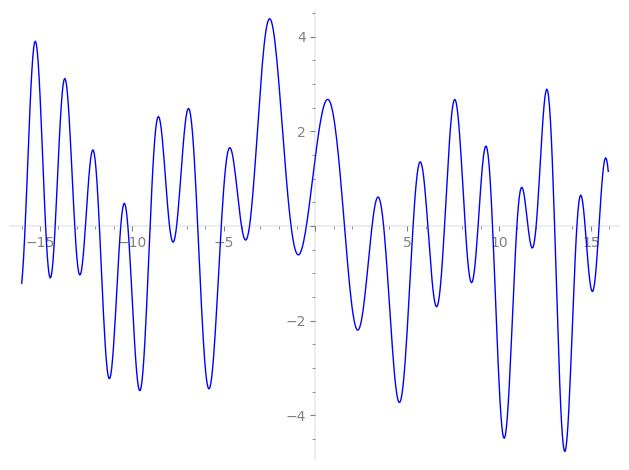| L(s) = 1 | + (−9.19 − 9.19i)5-s − 31.8i·7-s + (24.6 + 24.6i)11-s + (43.7 − 43.7i)13-s + 128.·17-s + (−36.8 + 36.8i)19-s − 97.8i·23-s + 44.1i·25-s + (70.2 − 70.2i)29-s − 280.·31-s + (−293. + 293. i)35-s + (−85.9 − 85.9i)37-s − 153. i·41-s + (−14.1 − 14.1i)43-s − 318.·47-s + ⋯ |
| L(s) = 1 | + (−0.822 − 0.822i)5-s − 1.72i·7-s + (0.676 + 0.676i)11-s + (0.933 − 0.933i)13-s + 1.83·17-s + (−0.444 + 0.444i)19-s − 0.886i·23-s + 0.353i·25-s + (0.449 − 0.449i)29-s − 1.62·31-s + (−1.41 + 1.41i)35-s + (−0.382 − 0.382i)37-s − 0.583i·41-s + (−0.0502 − 0.0502i)43-s − 0.987·47-s + ⋯ |
\[\begin{aligned}\Lambda(s)=\mathstrut & 576 ^{s/2} \, \Gamma_{\C}(s) \, L(s)\cr =\mathstrut & (-0.833 + 0.551i)\, \overline{\Lambda}(4-s) \end{aligned}\]
\[\begin{aligned}\Lambda(s)=\mathstrut & 576 ^{s/2} \, \Gamma_{\C}(s+3/2) \, L(s)\cr =\mathstrut & (-0.833 + 0.551i)\, \overline{\Lambda}(1-s) \end{aligned}\]
Particular Values
| \(L(2)\) |
\(\approx\) |
\(1.477054498\) |
| \(L(\frac12)\) |
\(\approx\) |
\(1.477054498\) |
| \(L(\frac{5}{2})\) |
|
not available |
| \(L(1)\) |
|
not available |
\(L(s) = \displaystyle \prod_{p} F_p(p^{-s})^{-1} \)
| $p$ | $F_p(T)$ |
|---|
| bad | 2 | \( 1 \) |
| 3 | \( 1 \) |
| good | 5 | \( 1 + (9.19 + 9.19i)T + 125iT^{2} \) |
| 7 | \( 1 + 31.8iT - 343T^{2} \) |
| 11 | \( 1 + (-24.6 - 24.6i)T + 1.33e3iT^{2} \) |
| 13 | \( 1 + (-43.7 + 43.7i)T - 2.19e3iT^{2} \) |
| 17 | \( 1 - 128.T + 4.91e3T^{2} \) |
| 19 | \( 1 + (36.8 - 36.8i)T - 6.85e3iT^{2} \) |
| 23 | \( 1 + 97.8iT - 1.21e4T^{2} \) |
| 29 | \( 1 + (-70.2 + 70.2i)T - 2.43e4iT^{2} \) |
| 31 | \( 1 + 280.T + 2.97e4T^{2} \) |
| 37 | \( 1 + (85.9 + 85.9i)T + 5.06e4iT^{2} \) |
| 41 | \( 1 + 153. iT - 6.89e4T^{2} \) |
| 43 | \( 1 + (14.1 + 14.1i)T + 7.95e4iT^{2} \) |
| 47 | \( 1 + 318.T + 1.03e5T^{2} \) |
| 53 | \( 1 + (-233. - 233. i)T + 1.48e5iT^{2} \) |
| 59 | \( 1 + (46.8 + 46.8i)T + 2.05e5iT^{2} \) |
| 61 | \( 1 + (36.7 - 36.7i)T - 2.26e5iT^{2} \) |
| 67 | \( 1 + (-122. + 122. i)T - 3.00e5iT^{2} \) |
| 71 | \( 1 - 268. iT - 3.57e5T^{2} \) |
| 73 | \( 1 + 774. iT - 3.89e5T^{2} \) |
| 79 | \( 1 + 30.1T + 4.93e5T^{2} \) |
| 83 | \( 1 + (-294. + 294. i)T - 5.71e5iT^{2} \) |
| 89 | \( 1 - 156. iT - 7.04e5T^{2} \) |
| 97 | \( 1 - 485.T + 9.12e5T^{2} \) |
| show more | |
| show less | |
\(L(s) = \displaystyle\prod_p \ \prod_{j=1}^{2} (1 - \alpha_{j,p}\, p^{-s})^{-1}\)
Imaginary part of the first few zeros on the critical line
−10.22001095040670563189043793577, −9.007729426748276851854993747243, −7.949004299217837914412899523372, −7.56349975687709464701328276121, −6.41385728599096968908982799631, −5.13157041468116397385447337498, −4.02850008609826582756586134193, −3.59099851569937413140336572718, −1.32965042982181593463983057061, −0.49555822730635948663781110073,
1.58083296328021110614445936166, 3.08260754044470891228659418277, 3.71252972928523789791105659895, 5.31759804692341146320263009130, 6.12223323621760963249015905393, 7.03072348750036105640349865682, 8.158506356103507600951781748510, 8.857944753972680781883970437108, 9.645040096856814728223832366806, 10.97246179733240877654262597094

